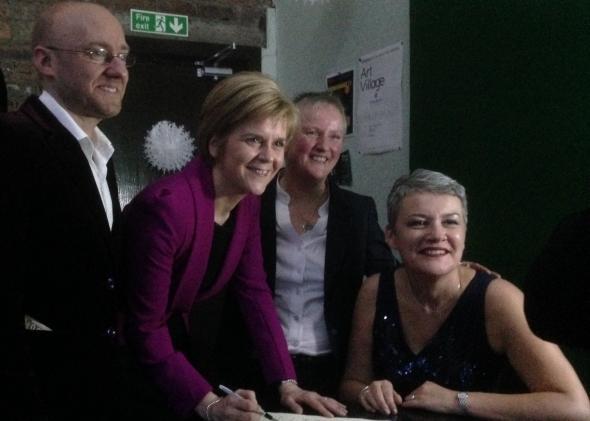GLASGOW, Scotland—Hogmanay has always held a special place in the hearts of Scots. Dec. 31—New Year’s Eve to non-Scots—was traditionally more important than Christmas Day, which wasn’t even a public holiday here until the late 1950s. Old traditions hold sway. Families and friends gather, tell stories, and sing old songs until the early hours. An awful lot of Robert Burns is recited. After The Bells” at midnight, homes expect to be blessed by a “first-footer,” who comes to the door bearing coal, whisky, and a fruited pastry called a “black bun,” all of which ensures the family has fuel, drink, and food for the coming year.
And this morning, at one minute past midnight on Hogmanay, we were party to a new custom. Dec. 31, 2014, was the first date on which lesbians and gay men could legally marry each other in Scotland. Civil partnerships have been available here since 2005, and conversion from civil partnership to marriage has been possible since Dec. 16, 2014.
More than 50 of us gathered in a bistro in the south side of Glasgow to witness the marriage of Gerrie and Susan Douglas Scott at precisely one minute past midnight, closely followed by two other couples eager to move to another level of equality. What was extra-special about this ceremony, among the many others taking place across Scotland, was that Susan and Gerrie’s witnesses were Nicola Sturgeon, Scotland’s first minister and the leader of the Scottish National Party, and Patrick Harvie, co-leader of the Scottish Green Party. Both politicians were leading lights in the legislative fight for equal marriage, and both are committed and vociferous supporters of full equal rights. Patrick is, in fact, one of a number of out LGBT members of the Scottish Parliament, and Nicola held the brief for equalities when she was Cabinet secretary for health and wellbeing. Today, the first minister said, “This a momentous day for equality in Scotland, one where same-sex couples have the right to marry the person that they love. This will send a powerful message to people about the kind of country we are.”
A number of speakers at the event referenced the long struggle for equality; they also pointed out the ways in which Scotland’s legislation is much closer to full equality than that of England and Wales, where, for example, the “state” churches are expressly prohibited from offering same-sex ceremonies; in Scotland, faith and belief groups may chose whether or not to do so. In Scotland, people between the ages of 16 and 18 do not require parental permission to marry. In the past, this led to the phenomenon of couples “eloping to Gretna Green,” the closest town to the Scottish-English border, where they could legally be married without their parents’ permission. The Scottish Tourist Board is already considering the potential windfall …
Tonight, after The Bells, we will all sing the Robert Burns song “Auld Lang Syne,” which Scotland has given to the world. Traditionally, it is said to refer to bidding farewell to old ideas while holding fast to old friendships. For non-Scots speakers—Burns wrote in a Lowland Scots tongue—the most difficult verse goes:
And here’s a hand, my trusty fiere!
and gie’s a hand o’ thine!
we’ll tak’ a right gude-willie waught,
for auld lang syne.
A free translation of this could be: “Shake hands, greet your friends, and get utterly blootered.” Quite a lot of LGBTQ people, their friends, and allies will be following Burns’ instructions tonight.
